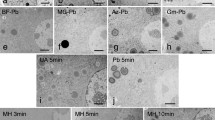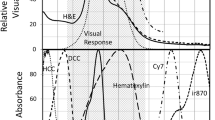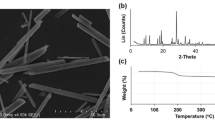Abstract
CURRENT histochemical techniques for carbohydrates depend on the fact that many of these substances possess groupings capable of being oxidized to yield aldehyde residues, which can then be made visible with Schiff's reagent. Glegg, Clermont and Leblond1 showed that when lead tetraacetate (in glacial acetic acid) replaced periodic acid as the oxi-dant, the histological distribution of the reaction with Schiff's reagent was similar although the intensity at some sites differed. If this difference in the intensity of the Schiff reactions were due to preferential oxidation of cis α-glycol groupings by lead tetraacetate2, then boric acid, which readily complexes with cis-hydroxyl groups (for example, in carbohydrates)3, might be expected to block the oxidation of such groups and thus modify the subsequent Schiff reaction.
This is a preview of subscription content, access via your institution
Access options
Subscribe to this journal
Receive 51 print issues and online access
$199.00 per year
only $3.90 per issue
Buy this article
- Purchase on Springer Link
- Instant access to full article PDF
Prices may be subject to local taxes which are calculated during checkout
Similar content being viewed by others
References
Glegg, R. E., Clermont, Y., and Leblond, C. P., Stain Tech., 27, 277 (1952).
Hockett, R. C., and McClenahan, W. S., J. Amer. Chem. Soc., 61, 1667 (1939). Hockett, R. C., Dienes, M. T., and Ramsden, H. E., J. Amer. Chem. Soc., 65, 1474 (1943).
Böeseken, J., “Adv. Carbohydrate Chem.”, 4, 189 (1949).
Staple, P. H., “Brit. Dent. Ann.”, 1, 127 (1952). Mowry, R. W., Longley, J. B., and Millican, R. C., J. Lab. Clin. Med., 39, 211 (1952).
Bell, D. J., and Baldwin, E., J. Chem. Soc., 125 (1941).
Kent, P. W., and Whitehouse, M. W., “Biochemistry of the Amino-sugars” (Butterworths, London, 1955).
Staple, P. H., Brit. Dent. J., 95, 289 (1953).
Glegg, R. E., Eidinger, D., and Leblond, C. P., Science, 118, 614 (1953).
McManus, J. F. A., and Cason, J. E., Arch. Biochem., 34, 293 (1951). Bangle, R., and Alford, W. C., J. Histochem. Cytochem., 2, 62 (1954). Glegg, R. E., Eidinger, D., and Leblond, C. P., Science, 118, 614 (1953). Windrum, G. M., Kent, P. W., and Eastoe, J. E., Brit. J. Exp. Path., 36, 49 (1954).
Author information
Authors and Affiliations
Rights and permissions
About this article
Cite this article
STAPLE, P. Blocking of Lead Tetraacetate-Schiff Reactions in Tissue Sections by Boric Acid. Nature 176, 1125–1126 (1955). https://doi.org/10.1038/1761125a0
Issue Date:
DOI: https://doi.org/10.1038/1761125a0
This article is cited by
-
Some comments on the PAS reaction of glycogen
The Histochemical Journal (1969)
Comments
By submitting a comment you agree to abide by our Terms and Community Guidelines. If you find something abusive or that does not comply with our terms or guidelines please flag it as inappropriate.



